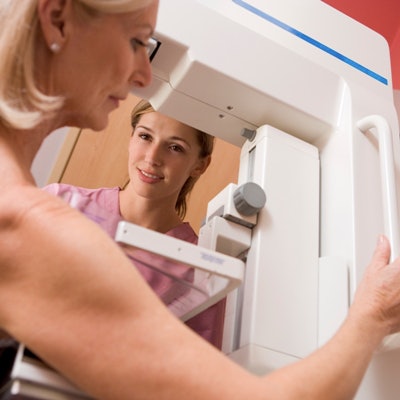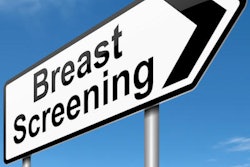
A new analysis of more than 11 million breast screening exams from the English National Health Service (NHS) program has shown that increases in recall rates above defined levels are nearly always associated with false-positive recalls and a very small increase in detection of low/intermediate-grade ductal carcinoma in situ (DCIS).
This finding confirms that high recall rates are not associated with increases in detection of life-threatening cancers, according to senior author Dr. Matthew Wallis and colleagues. Their article was published online on 4 February in European Radiology.
The study methods may help countries with mammography screening programs determine their optimal recall rates, as well as help the English screening program set its own recall rate target, they explained.
 Dr. Matthew Wallis, consultant radiologist at the Cambridge University Hospitals NHS Foundation Trust.
Dr. Matthew Wallis, consultant radiologist at the Cambridge University Hospitals NHS Foundation Trust."We've always suspected that low and high recall rates weren't good, but this is the first time we've had such large numbers to measure their real impact," said Wallis, a consultant radiologist at the Cambridge University Hospitals NHS Foundation Trust.
Screening programs aim to detect breast cancer early to reduce death rates and maximize treatment success, but the drive to detect more breast cancers can lead to overdiagnosis, overtreatment, and high recall rates, the authors explained.
Recall rates vary widely among countries, with rates varying from 2% in the Netherlands to 12% in the U.S. The benefit of detecting low-grade DCIS is controversial because it has a low rate of progression, the researchers wrote. Women who are recalled can face a clinical examination, further imaging, and -- if results are suspicious -- a needle biopsy, which can lead to patient anxiety and societal costs.
With the current study, the researchers aimed to set specific targets for evidence-based recall rates and understand how to determine optimum recall rates in breast cancer screening.
The team analyzed data from 11,258,620 screening exams performed on women between the ages of 45 and 70, carried out at the 80 English screening units between April 2009 and March 2016. These included women ages 50 to 70 invited to routine mammography screenings every three years and women ages 45 to 52 invited to join AgeX (a trial looking at the benefits of extending England's screening program to younger and older ages).
The researchers modeled the percentage of cancers detected by increasing recall rates, invasive cancers detected versus low-grade DCIS, and recalls of women without cancer. They found that invasive cancers were detected at lower recall rates than low/intermediate-grade DCIS. High-grade DCIS and grade 3 invasive cancers were generally detected at the lowest recall rates.
Among younger women being screened for the first time, most additional recalls above a rate of 7% were false positives. Older women having a repeat screen saw false-positive recalls above a rate of 4%, with only a small increase in the detection of low/intermediate-grade DCIS.
Nearly all grade 3 invasive cancers were detected at a recall rate of 2.5%, grade 2 cancers at a rate of 3.9%, and grade 1 cancers at a rate of 5.2%. Detecting more than 99% of cancers had rapidly diminishing returns, with a steep increase in false-positive recall rates and only a small increase in detection of low/intermediate-grade DCIS.
Wallis and colleagues concluded that 99% of invasive cancers and high-grade DCIS are detected at an estimated recall rate of 7%, and although low/intermediate-grade DCIS continues to be detected above this level, false-positive rates rise rapidly, raising questions over the balance between harm and benefit.
The study findings concur with comparisons of U.S. and U.K. data, which show higher recall rates in the U.S. but similar invasive cancer detection rates, they continued, noting that the results appear to improve the evidence base for recall-rate targets.
In particular, a quarter of English screening units currently have recall rates below 2.6%. The team suggests the study shows that a recall rate of approximately 3.1% for repeat screens would help detect more invasive cancers.
"We now have hard evidence to encourage programs with very low recall rates to review this practice but, most importantly, we can see the effect of high recall rates on false positives and the effect of grade, so that individuals and QA [quality assurance] systems can ask tough questions," Wallis noted.
Wallis works with the Cambridge Breast Cancer Research Institute, which aims to search for new ways of monitoring response to existing treatment and new drugs with the goal of developing personalized treatment for every woman with breast cancer. According to his bio on the website of the Cambridge University Hospitals NHS Foundation Trust, he has received grants from the following sources:
- Cancer Research UK, to optimize image quality for new digital and computerized techniques with the National Co-ordinating Centre for the Physics of Mammography: This project formed part of the Optimam Mammography Image Database (OMI-DB), an extensive mammography image database of over 80,000 unprocessed and processed digital images.
- The supporters of the low-risk DCIS (LORIS) trial comparing surgery with active monitoring for low-risk DCIS: Wallis is the chief investigator for the study, which began in July 2014 and is due to end in 2020.
- Philips Healthcare, for the development of new mammography techniques

















